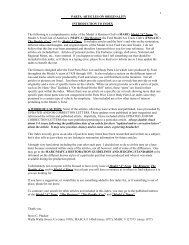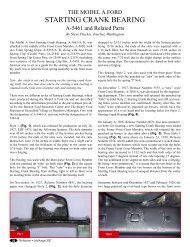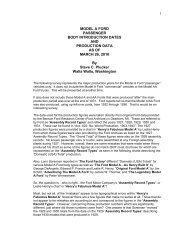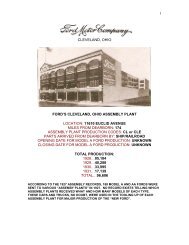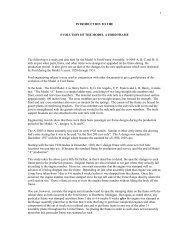Ford Ford - Steve Plucker
Ford Ford - Steve Plucker
Ford Ford - Steve Plucker
- No tags were found...
You also want an ePaper? Increase the reach of your titles
YUMPU automatically turns print PDFs into web optimized ePapers that Google loves.
<strong>Ford</strong>Assembly Plant and DealershipBills of SaleWhat Can They Tell Us About Model A <strong>Ford</strong> Production?By <strong>Steve</strong> C. <strong>Plucker</strong>Touchet, WashingtonEver since the <strong>Ford</strong> Archives fire onAugust 9, 1970, which destroyed alot of important historical documentsconcerning the Model A <strong>Ford</strong> andother models, the Model A hobbiest andresearcher has had to rely on documentsthat are in collectors hands for part of the<strong>Ford</strong> story. Although the new <strong>Ford</strong>Archives still have quite a few Model A<strong>Ford</strong> documents to view and research,those that pertained to the specific assemblyand service plants have all but vanished.If it was not for the survival of the1928-1931 Indianapolis and 1930-1931Chicago Service Letters and the 1928Fargo Service Letters, we would be lost intrying to determine when specific changeswere made.8 The Restorer • May/June 2006However, some other documents that havesurvived all these years that can put a specificpaper trail on any Model A <strong>Ford</strong>, providingone can be associated with a knownoriginal vehicle, are the <strong>Ford</strong> AssemblyPlant and <strong>Ford</strong> Dealership Bill of Sales.These documents can tell us lots about theModel A itself as far as the productionaspect goes.During the Model A years, 1928-1931,there were 32 assembly and three wholesaleservice plants throughout the UnitedStates. The major production and assemblyplant was the Rouge Plant (engineassemblies, fenders, body panels, paperproducts, electrical wire, steering wheels,glass production and other items) inDearborn, Michigan. Other <strong>Ford</strong> “partsmanufacturing” plants were located atKearny, New Jersey (also an assemblyplant); Hamilton, Ohio (steel wheel production);Flat Rock, Michigan; GreenIsland, New York (radiator production);St. Paul, Minnesota (glass production);Glassmere, Pennsylvania (glass production);Iron Mountain (iron mine and lumberproduction); Highland Park (<strong>Ford</strong>sgiant machine shop and the Henry <strong>Ford</strong>Trade School, also paints, ammeters,crankshafts and other forgings, such as theengine, axle, etc., were manufacturedhere). Phoenix, Northville, Waterford,Plymouth and Nankin Mills, Michiganwere also other minor manufacturingplants. Dearborn, Michigan, was the siteof <strong>Ford</strong>’s experimental laboratory, as wellas the <strong>Ford</strong> Airport and the airplane manufacturingplant. Other items also camefrom outside sources such as the carburetor;electrical items as horns, distributors,spark plugs, batteries, generators; shocks;steering gears; wheels; tires; etc.Once the parts were finished, they werethen transferred to the Rouge Plant wherethey were arranged for assembly and/or
Example of hand-written Dealer Bill of Sale.tion or the engine storage room for shipmentto an assembly plant. If the enginedid not meet <strong>Ford</strong>’s standards or if therewas a problem with it, the engine was thenput aside and repaired then sent on itsway. If it could not be fixed, it wasdestroyed.Once the orders were placed from the variousassembly plants (or maybe <strong>Ford</strong> designatedwhat went where) and the freightcars were loaded with parts, the train wason its way. As stated above, the RougePlant was the major manufacturing plantfor all the <strong>Ford</strong> parts with the exception ofsome outside plants to take care of someother parts. The Rouge Plant was also anassembly plant that assembled both carsand trucks. But there were also otherassembly plants located at strategic tradecenters throughout the United States.These plants were indicated by theirknown, equated assembly plant lettercodes: (A or AA) Atlanta, Georgia; (BO)Buffalo, New York; (CE) Charlotte, NorthCarolina; (CR) Chester, Pennsylvania;(CHI) Chicago, Illinois; (CI) Cincinnati,Ohio; (CL or CLE) Cleveland, Ohio; (G)Columbus, Ohio; (DS) Dallas, Texas;(DR) Denver, Colorado; (DM) DesMoines, Iowa; (F) Dearborn (The Rouge),Michigan (FD noted on an early 1928Tudor); (E) Edgewater, New Jersey; (H)10 The Restorer • May/June 2006Houston, Texas; (I) Indianapolis, Indiana;(JE) Jacksonville, Florida; (KC?) KansasCity, Missouri; (KY) Kearny, New Jersey;(LA) Long Beach, California; (LA) LosAngeles, California (the month and yearappear as part of the number); (LE)Louisville, Kentucky (the month and yearappear as part of the number); (MEM)Memphis, Tennessee (sometimes has anAX preceding the number); (?)Milwaukee, Wisconsin; (NO) NewOrleans, Louisiana (the number “2” precedesthe NO); (NK) Norfolk, Virginia;(OC) Oklahoma City, Oklahoma; (?)Omaha, Nebraska (possibly used AU); (?)Pittsburgh, Pennsylvania; (PO) Portland,Oregon; (R) Richmond, California; (SFAor SFAA) San Francisco, California; (AS)Seattle, Washington; (S, SAX or SAXC)Somerville, Massachusetts; (STL) St.Louis, Missouri (has AX preceding theSTL); and (TC) Twin City, St. Paul.Minnesota. The three wholesale serviceplants were in Washington, D. C., Fargo,North Dakota, and Salt Lake City, Utah.These three plants did not assemble anycars or trucks. However they may havebeen a drop off locations of assembledcars and trucks which were to be transportedto their closest dealerships.Following the assembly plant letter codeswere numbers. These numbers werestamped at the time of assembly of thebody at their respective assembly plant.All letters and numbers were stamped intothe front cross member of the body itself,a few into the body side rails on the floorboard level, or into the wooden crossmember on certain body styles asCabriolets and <strong>Ford</strong>ors. Such asSFA192831. They can be located anywhereon the body’s floor cross sill frontassembly and can be oriented to read fromdriver to passenger side, from passenger todriver side, or from back to front.However in some cases they are not thereat all! The numbers represented the numberof bodies that had been assembled ateach assembly plant at a certain point intime. Dave Sturges, of Glenwood,Maryland, has been researching this aspectof the body assembly plant codes andnumbers and has been trying to identifythe Model A <strong>Ford</strong> Assembly Plant LetterCodes used. He needs your help. For moreinformation on this, see The Restorer –September/October, 1997 and May/June,2001. He may be contacted at: DaveSturges, 14505 MacClintock Drive,Glenwood, MD 21738-9626; Phone: (410)442-2724; Email: dasturge@comcast.net.For study: see www.mafca.com.According to Ed Francis and GeorgeDeAngelis, in their article of theMarch/April, 1977 issue of Model A Newstitled “Establishing Model A ProductionDates,” the assembly plants were dividedinto three categories:1. “Major”: which produced bodies for itsown line, but also produced bodies forother assembly plants. The following is aknown “major” assembly plant: RougePlant.2. “Standard”: which assembled bodiesfrom partly assembled kits supplied by the“major” assembly plants or vendor bodycompanies such as Budd, Murray andBriggs. They did not have stampingmachinery. The following is a known“standard” assembly plant: Louisville.3. “Minor”: which had limited facilitiesand they received completely built-upbodies from the “major” assembly plantsor from vendor body companies. The followingare known “minor” assemblyplants: Cleveland, Jacksonville andPortland.Trying to figure out just how long it took aparticular freight train to go from theRouge Plant to the various assemblyplants was a feat in itself.Mr. Hilding Larson, Union Pacific historian,related that it took about 10 days to gofrom the Rouge Plant to <strong>Ford</strong>’s assemblyplant in Seattle, Washington, closer oneswere not as long. Neil Besougloff, Editorof Classic Toy Trains and fellow ModelA’er, indicated several factors that affectedtrain times in the ‘20’s and ‘30’s. Thefirst was geography: (the distance from theRouge Plant to the various assemblyplants); the second factor was the way therailroads were laid out: (there were abouttwo dozen major railroad lines during thistime period thus using the same line to gofrom one place to another would be quickerthan changing from one line to another);the third factor was the amount of transfersthe boxcar or boxcars were putthrough on their destination: (just howmany rail lines the freight cars had to gothrough to reach its final destination,lengthened the time of arrival to theassembly plant); and a possible fourth factormay have been <strong>Ford</strong> himself (did <strong>Ford</strong>have any influence with the railroads to
get his rail cars to their final destinationquicker than other companies?).There were nine assembly plants within a379 mile radius of the Rouge Plant:1. Cleveland, Ohio (CL/CLE) 174 miles2. Columbus, Ohio (G) 206 miles3. Cincinnati, Ohio (CI) 272 miles4. Chicago, Illinois (CHI) 286 miles5. Pittsburgh, Pennsylvania (?) 291 miles6. Indianapolis, Indiana (I) 298 miles7. Buffalo, New York (BO) 365 miles8. Louisville, Kentucky (LE) 375 miles9. Milwaukee, Wisconsin (?) 379 milesThere were 13 assembly plants within a540 to 793 mile radius of the Rouge Plant:1. Chester, Pennsylvania (CR) 540 miles2. Edgewater, New Jersey (E) 540 miles3. Kearney, New Jersey (KY) 540 miles4. St. Louis, Missouri (STL) 547 miles5. Des Moines, Iowa (DM) 597 miles6. Charlotte, North Carolina (CE) 670 miles7. Twin City, St. Paul, Minn. (TC) 696 miles8. Norfolk, Virginia (NK) 721 miles9. Somerville, Massachusetts (S) 730 miles10. Atlanta, Georgia (A/AA) 732 miles11. Omaha, Nebraska (?) 734 miles12. Memphis, Tennessee (MEM) 757 miles13. Kansas City, Missouri (KC?) 793 milesThere were three assembly plants within a1,041 to 1,077 mile radius of the RougePlant:1. Oklahoma City, Oklahoma (OC) 1,041 miles2. Jacksonville, Florida (JE) 1,048 miles3. New Orleans, Louisiana (NO) 1,077 milesThere were three assembly plants within a1,211 to 1,324 mile radius of the RougePlant:1. Dallas, Texas (DS) 1,211 miles2. Denver, Colorado (DR) 1,274 miles3. Houston, Texas (H) 1,324 milesThere were five assembly plants within a2,297 to 2,411 mile radius of the RougePlant:1. Los Angles/Long Beach, Cal. (LA) 2,297 miles2. Seattle, Washington (AS) 2,359 miles3. Portland, Oregon (PO) 2,390 miles4. Richmond, California (R) 2,401 miles5. San Francisco, Ca. (SFA/SFAA) 2,411 milesThere were also three service centers:1. Washington, D. C.2. Fargo, North Dakota3. Salt Lake City, UtahThese service centers did not assemble any vehiclesthat is known. More information is needed here.Once the freight train arrived at the designatedassembly plant (or as in the case ofthe assembly plants on the West Coastwhich the parts may have been brought inby ocean steamer), they were unloadedand the parts were put in their right spot inthe assembly process or they remained inThis typed Dealer Bill of Sale, while more professional looking, does not list the key numbers.the boxcars until needed. The assemblycalled for chassis assembly, body assembly,and all the paint, trim and upholsterywork. Some of the plants manufacturedcushions, springs and closed bodies. Thebranches all operated under pretty muchthe same system, using the same standardof tools for building cars and trucks.Once the car or truck left the assemblyline, they were shipped out to one of thevarious <strong>Ford</strong> dealerships throughout theassembly plant’s territory for sale to thepublic. Some dealers sent drivers to theassembly plants to drive cars back to theirdealership for sale, these were referred toas “drive outs;” some were shipped byrailway cars; some by transport trucks,such as the Model AA <strong>Ford</strong> Taylor Trucka-Ways;and some were transported byboat. In some cases, the public were permittedto drive their car off the assemblyline.YEARDEARBORNBUFFALO365 milesJust how long did it take for parts to gofrom the Rouge Plant to the variousassembly plants and out the door to thepublic? What engines went where? Howlong did they sit around before beinginstalled into a chassis? Those were questionsI wanted to answer, but in essencecan only speculate because the shippingrecords of the various parts are not to befound, even at the archives. This is whywe have the “Early” (January, February,March and April); “Mid” (May, June, Julyand August); and “Late” (September,October, November and December)Definition of Dates in theMAFCA/MARC Judging Standards alongwith the fact that “in view of the lag timebetween drawing preparation and actualincorporation into production, and <strong>Ford</strong>’spolicy of often using the entire stock ofsuperseded parts, whenever a month isstated for the commencement of a configuration,the earlier configuration will alsobe acceptable for two months thereafter.”ST. LOUIS547 milesSOMERVILLE730 milesSAN FRAN2,411 miles1928 – 10-16 – 7-15 –1929 1 6-7 – 6-15 12-221930 1-10 3-10 6-21 6-15 341931 – 8 11-15 45-65 37-43This chart indicates the number of days it took to assemble a car or truck from engine stamping tothe time it left the assembly plant according to the assembly plant Bill of Sales.May/June 2006 • The Restorer11
But what kind of paperwork did <strong>Ford</strong> preparebefore shipping that car or truck fromthe assembly plant to a dealer? These documentsare represented by the <strong>Ford</strong> MotorCompany’s Buffalo Assembly Plant inNew York.Factory Bills of Sale, as seen below, canprovide us with some of the historical datathat may have been lost in the Archivesfire. Besides the cost of things, thisFactory Bill of Sale, Invoice numberF87575, relates that the car is a TownSedan with engine number A3308654(which was stamped at the Rouge Plant onMay 1, 1930). On May 6, 1930, the completedcar was sold to Brown andMcCooey, Inc., in Randolph, New York.It took just five days from the time theengine was stamped and related parts leftthe Rouge factory to go the 365 miles tothe Buffalo, New York assembly plantwhere it was assembled and out the door.What else does the Bill of Sale tell us? Ittells us of the ignition key number thatwas associated with the car, A891 and adoor key, A1139. However, most assemblyplant Bills of Sale that were vieweddid not have the key codes on them. Thosewere mainly recorded on the dealershipBill of Sales.The only difference between the factoryand dealership Bills of Sale were theappearance of the slips themselves. Somedealership Bills of Sale were professionallydone, while others were simply handwrittenreceipts. Both included the keycodes numbers as recommended by <strong>Ford</strong>.According to the May 16, 1928 notificationfrom the Fargo, North Dakota, servicebranch to the dealers, it related that “Inorder to eliminate the possibility of inconvenienceto your A and AA ownersthrough loss of door locks and ignitionswitch keys, we recommend that youplace the key numbers required for the caror truck on the bill of sale.” Apparentlythis was not being done by some <strong>Ford</strong>dealers and in the February 20, 1929,Indianapolis Service Letter, <strong>Ford</strong> issuedanother statement requesting that this bedone in order to let customers know justwhat their key codes were in case theyfound it necessary to replace them.Unlike the Factory Bills of Sale, trying toestablish an assembly time of a vehicle inviewing Dealership Bills of Sale, is kindof hard to do taking into consideration the12 The Restorer • May/June 2006amount of time the vehicle sat on the dealershipslots or maybe it was used as ademonstrator vehicle for a series ofmonths.So just how long did it take to assemblethat Model A/AA <strong>Ford</strong>? One has to look atthe data very objectively. Was that enginesent to the assembly line immediatelyupon its arrival to the assembly plant orwas it stuck in the corner only to beretrieved one to eight weeks later or morebefore assembly? Did the completed vehicleget sent immediately to a dealer afterassembly or did it sit around the assemblyplant for one to eight weeks or more waitingto get picked up by a dealer? Hard totell.The chart on page 11 gives us some ideaof just how many days it took to assemblea Model A or AA <strong>Ford</strong> at the variousassembly plants from the time the enginewas stamped at the Rouge Factory inDearborn, Michigan, thus being receivedat the assembly plants themselves and thecompleted vehicle out the door. The datacame from a number of original <strong>Ford</strong>Factory (Assembly Plant) Bills of Sale todealerships.The farther the assembly plant was fromthe Rouge Factory in Dearborn, the longerthe time it was in getting the vehicles offthe assembly lines and into the dealershands.I would like to thank Jerry Bengel, NeilBesougloff, Hilding Larson, Jim Spawn,Dave Sturges and Lynn White for theirthoughts and contributions to this article.I would also like to thank those of youwho have contributed the many <strong>Ford</strong>Factory and Dealership Bills of Sale thatwere used to arrive at the data that wasused in this article including RayBeardslee, Rich Bell, Arlyn Bieber, ClemClement, Dean Drenzek, Martin Hanshew,Clif Moebius, Jerry Parr, Tom Pearson,Todd Smith, Lou Tull, Tom Wesenberg,Mark Williamson and Peter Winnewisser.This is an ongoing study. I hope that thoseof you who have original <strong>Ford</strong> Factoryand Dealership Bills of Sale will contributeyour data to this study, which willbe put into a data base for future generationsto come. Please contact me atsteve@plucks329s.org and visit my website at www.plucks329s.org for furtherinformation.




